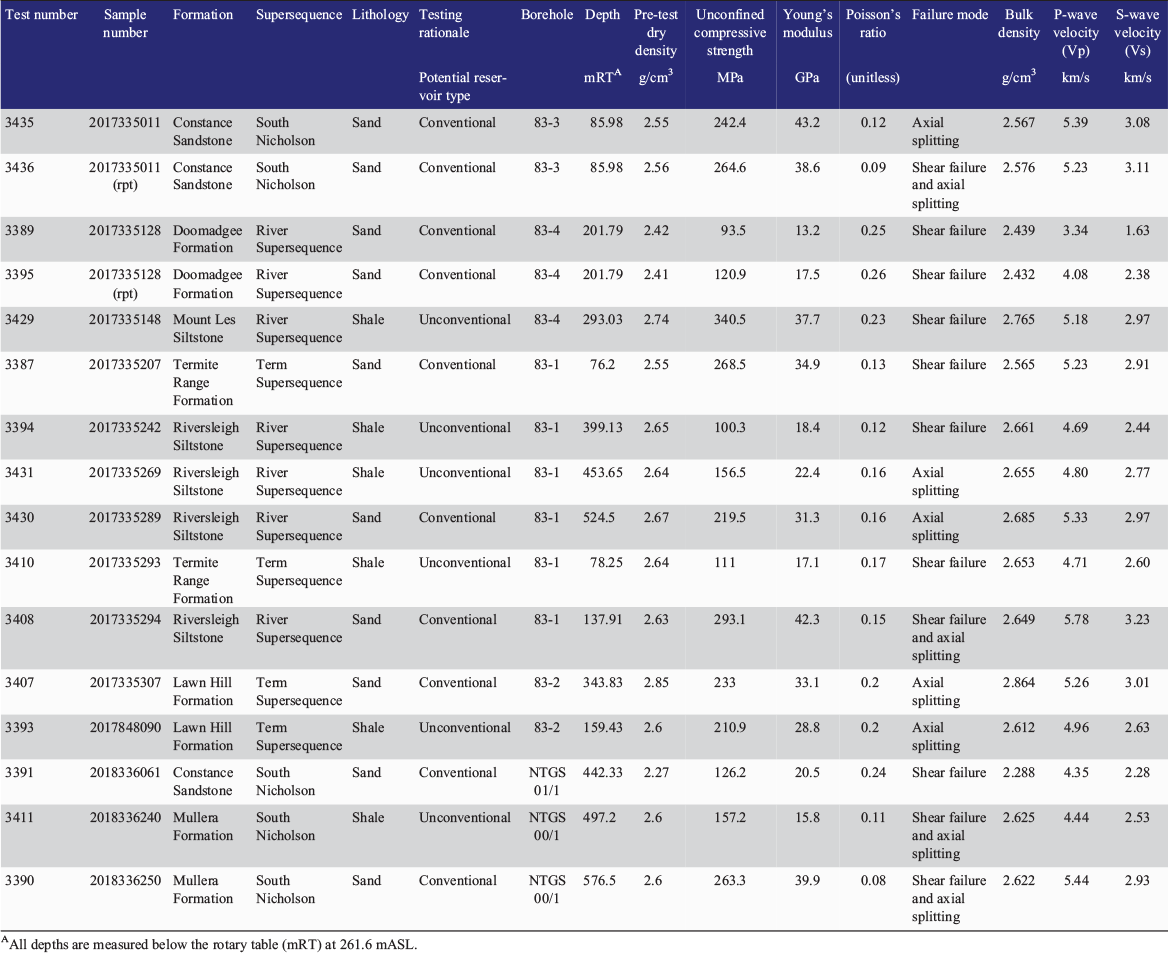Exploring for the Future geomechanics: breaking down barriers to exploration
Adam H. E. Bailey A D , Amber J. M. Jarrett A C , Liuqi Wang A , David N. Dewhurst B , Lionel Esteban B , Shane Kager B , Ludwig Monmusson B , Lidena K. Carr A and Paul A. Henson AA Geoscience Australia, 101 Jerrabomberra Avenue, Symonston, ACT 2609, Australia.
B CSIRO Energy, 26 Dick Perry Avenue, Kensington, WA 6151, Australia.
C Present address, Northern Territory Geological Survey, GPO Box 4550, Darwin, NT 0811, Australia.
D Corresponding author. Email: adam.bailey@ga.gov.au
The APPEA Journal 61(2) 579-587 https://doi.org/10.1071/AJ20039
Accepted: 22 February 2021 Published: 2 July 2021
Journal Compilation © APPEA 2021 Open Access CC BY
Abstract
Exploring for the Future (EFTF) is an Australian Government initiative focused on gathering new data and information about potential mineral, energy and groundwater resources across Australia. The energy component of EFTF, initially focussed on northern Australia, aims to improve our understanding of the petroleum potential of frontier Australian basins. Building an understanding of geomechanical rock properties is key to understanding both conventional and unconventional petroleum systems as well as carbon storage and sedimentary geothermal systems. Under EFTF, Geoscience Australia has undertaken geomechanical work including stress modelling, shale brittleness studies and the acquisition of new rock property data through extensive testing on samples from the Paleo- to Mesoproterozoic South Nicholson region of Queensland and the Northern Territory, and the Paleozoic Kidson Sub-basin of Western Australia. Work in these regions demonstrates regional stress orientations in broad agreement with previously modelled, continent-scale stress orientations and stress magnitudes that vary through the basin with depth and by lithology. Rock testing highlights potentially brittle shales and demonstrates variable rock properties in line with lithology. These analyses are summarised herein. Providing baseline geomechanical data in frontier basins is essential as legacy data coverage can often be inadequate for making investment decisions, particularly where unconventional plays are a primary exploration target. As EFTF increases in scope, Geoscience Australia anticipates expanding these studies to encompass further underexplored regions throughout Australia, lowering the barrier to entry and encouraging greenfield exploration.
Keywords: Exploring for the Future, Canning Basin, Kidson Sub-basin Isa Superbasin, South Nicholson region, geomechanics, rock strength, stiffness, velocity, brittleness, mineralogy, porosity, permeability, seal capacity, Young’s modulus, Poisson’s ratio, present-day stress, in situ stress, stress regimes, Barnicarndy 1.
Introduction
The Australian Government’s Exploring for the Future (EFTF) program launched in 2016 with funding provided to Geoscience Australia to explore Australia’s resource potential and boost investment on northern Australia. In 2020, an additional 4 years of funding, to expand the program nationwide, was announced. To date, the energy component of EFTF aimed to attract industry investment through the delivery of a suite of new pre-competitive geoscience data and knowledge of the oil and gas prospectivity of sedimentary basins across northern Australia. For industry to commit to exploration in frontier regions, additional pre-competitive datasets are needed to adequately evaluate resource potential and recoverability. Provision of these data aids with de-risking an area and gives industry the confidence to initiate exploration activities.
Geomechanical and petrophysical properties of prospective formations form one such dataset. Building an understanding of these properties is key to understanding petroleum systems as well as geological carbon storage and sedimentary geothermal systems; anywhere rock properties can be a key constraint. Geoscience Australia has undertaken geomechanical studies of legacy datasets and new precompetitive data acquired during EFTF. This work includes stress modelling, shale brittleness studies and the acquisition of rock property data through laboratory analysis of samples from existing and new wells.
New geomechanics data
The energy component of the first phase of EFTF focused on two main frontier regions: the Paleozoic Kidson Sub-basin of Western Australia’s Canning Basin and the Proterozoic South Nicholson region straddling the Queensland/Northern Territory border as described by Jarrett et al. (2020a). Alongside studies of legacy data, significant new regional deep-crustal 2D seismic reflection data were acquired over the Kidson Sub-basin in 2018 and the South Nicholson region in 2017 and 2019 under the EFTF program. These were followed by the drilling of the stratigraphic wells Barnicarndy 1 (previously Waukarlycarly 1) in 2019 (in partnership with the Geological Survey of Western Australia) and Carrara 1 in 2020 (in partnership with the MinEX CRC).
Canning Basin
Kidson Sub-basin
A structural feature of the Lower Ordovician to Lower Cretaceous Canning Basin, the Kidson Sub-basin is a large, underexplored depocentre that possibly hosts a continuation of proven Canning Basin petroleum systems (Carr et al. 2020; Southby et al. 2020). Canning Basin data have been used to provide detail on present-day stresses and provide broad constraints for basin stresses within the Kidson Sub-basin (Bailey et al. 2021). Additionally, conventional and unconventional reservoir rock properties were characterised through laboratory tests undertaken on freshly acquired core samples from Barnicarndy 1 (Jarrett et al. 2020c).
Canning Basin present-day stresses
Wireline log data, including wellbore image logs, were interpreted from open-file wells to define the Canning Basin’s stress orientations and magnitudes. An NE-SW regional present-day maximum horizontal stress orientation is interpreted from observed wellbore failure, and is in broad agreement with the Australian Stress Map and previously published earthquake focal mechanism data (Bailey et al. 2021). In the Barnicarndy Graben (previously Waukarlycarly Embayment), maximum horizontal stress orientation is interpreted as ~E-W (Wilson and Thrane 2020) supporting predictions of continent-scale stresses (Rajabi et al. 2017). An overall strike-slip faulting stress regime is interpreted through the basin; however, three distinct stress zones are identified through the studied interval:
a reverse to strike-slip faulting stress regime in the <~1.0 km depth range,
a strike-slip faulting stress regime from ~1.0 km to ~3.0 km depth, and,
a strike-slip to normal faulting regime at > ~3.0 km depth.
Mechanical earth models, built for 15 Canning Basin wells, demonstrate variable present-day stresses within the Canning Basin and highlight the relationship between lithology and stress (Bailey et al. 2021). Significant stress changes are interpreted within and between lithologies, defining discrete mechanical units that form inter- and intraformational stress boundaries. The lithological units likely act as natural barriers to fracture propagation, particularly within those currently targeted for their unconventional resource potential (Bailey et al. 2021).
A similar distribution of stresses to that in the legacy data is observed in the preliminary mechanical earth model constructed for Barnicarndy 1 (Fig. 1); a shallow reverse faulting stress regime is interpreted through to ~1 km depth, with a strike-slip faulting stress regime through the bulk of the well. There are indications that at depths > ~2.5 km, the stress regime transitions towards a normal faulting stress regime; however, the well penetrates underlying basement rocks at ~2.6 km depth where a reverse faulting stress regime is interpreted (Fig. 1).

|
Barnicarndy 1 rock testing program
Rock mechanics testing targeted potential reservoir-seal pairs, characterising mechanical and petrophysical properties through unconfined compressive stress (UCS) tests, ultrasonic testing under load (at ~50% peak strength), mercury injection capillary pressure (MICP), broad-ion-beam milling and scanning electron microscopy (BIB-SEM), and gas porosity and permeability tests (CSIRO 2020; Jarrett et al. 2020c). Six Barnicarndy 1 core samples were analysed, with sampling dependent on core integrity (Table 1). Very low Poisson’s ratios imply that these rocks are likely to be brittle, with shales in particular demonstrating brittle behaviour – stress–strain curves demonstrate a pronounced peak strength, followed by fracturing and a resultant load bearing capacity of zero (Fig. 1) (Jarrett et al. 2020c). Measured UCS values are typical for lithology and porosity, although some may be slightly overestimated due to axial splitting mode of failure (Table 1); the uppermost clean sandstone (1127.1 mRT) is porous and permeable (Table 1); hence, it has lower strength than deeper sandstones. The deeper sandstones are tighter, stronger and have higher Young’s moduli, implying that they require more stress to deform than the shallow sandstone (Table 1).

|
Further testing was undertaken to understand the diamictite’s seal potential (Table 1). Analysis via MICP and BIB-SEM demonstrates a composition primarily of very poorly sorted quartz, K-feldspar and plagioclase grains that are rarely in contact and are surrounded by a fine grained, extremely tight, matrix (CSIRO 2020). Capillary pressures are estimated from 6888 to 8588 psi (45.4–59.2 MPa), providing a sealing capacity able to contain an ~800 m column of CH4 or ~600 m of CO2 (CSIRO 2020).
South Nicholson region
Jarrett et al. (2020a) defined the South Nicholson region as the extent of the sedimentary package composed of the Paleoproterozoic Isa Superbasin and overlying Mesoproterozoic South Nicholson Group, interpreted as south of the Murphy Inlier. Where present, younger overlying sediments and older underlying successions are included. Though informal, this study uses this terminology as it clearly defines the region of interest. The South Nicholson region is known to contain organic-rich units with the potential to host unconventional gas plays, particularly the River and Lawn supersequences of the northern Lawn Hill Platform that host the Egilabria shale gas prospect (Gorton and Troup 2018).
South Nicholson region present-day stresses
Interpretation of wellbore failure in image logs acquired in Egilabria 2 and Egilabria 4 reveals an approximately N-S to NNE-SSW maximum horizontal stress orientation, in agreement with predicted continent-scale stresses (Rajabi et al. 2017). Mechanical earth models for Egilabria 2 and Egilabria 4 reveal the present-day state of stress, defining a strike-slip faulting regime in the Egilabria Prospect (Fig. 1) and highlighting the relationship between lithology and stress. Sandstone and carbonate intervals exhibit significantly higher stress magnitudes than shale and siltstone intervals, resulting in localised stress variations (Bailey et al. 2019).
South Nicholson region shale brittleness
Shale brittleness in the South Nicholson region was analysed in two EFTF studies: Bailey et al. (2019) characterised the Egilabria prospect’s River and Lawn supersequences shales and Jarrett et al. (2019) studied controls over shale brittleness, potential methods for assessing shale brittleness, and how shale brittleness varies spatially and between Isa Superbasin supersequences. Results demonstrate that Isa Superbasin shale brittleness is controlled by increasing quartz and decreasing clay content, and that brittle shales are likely present within each supersequence. Notably, shales in the River and Lawn supersequences are interpreted as having brittle zones potentially favourable for fracture stimulation (Bailey et al. 2019; Jarrett et al. 2019).
South Nicholson region rock testing program
Rock property testing was undertaken on legacy South Nicholson region samples (Jarrett et al. 2020b). Mechanical and petrophysical properties were characterised through UCS tests and ultrasonic testing at ~50% peak strength during the UCS test (Jarrett et al. 2020b). Fourteen potential unconventional or conventional reservoir samples were analysed (Table 2). Notably, samples have high Young’s moduli, high UCS and low Poisson’s ratios (Table 2). While shales are potentially brittle due to their low Poisson’s ratio and zero load bearing ability after failure (Fig. 1), all rocks tested are hard and strong (Table 2), and hence, would require significant stresses to deform.

|
Summary
Geoscience Australia has released new geomechanical and petrophysical data within two prospective frontier regions, de-risking exploration through the provision of additional pre-competitive datasets. Analysis and modelling of present-day stresses, shale brittleness studies and newly acquired rock property data from the Proterozoic South Nicholson region and the Paleozoic Canning Basin are presented herein. These data provide geomechanical and petrophysical insights into intervals with identified or potential hydrocarbon prospectivity and allow for extrapolation of rock properties.
As the EFTF program expands in scope to cover more of the Australian continent, Geoscience Australia anticipates expanding these studies to encompass further frontier basins. The delivery of such data contributes to understanding large-scale variations in crustal stresses and local and regional changes in rock properties, lowering barriers to entry and encouraging greenfield exploration in remote, underexplored regions.
Conflicts of interest
All authors confirm there are no conflicts of interest.
Declaration of funding
This research was funded through the Australian Government Exploring for the Future program, led by Geoscience Australia.
Acknowledgements
We thank Darryl Stacey (NTGS), Chris Hansen (GSQ), Berny Parkes (GSQ) Paul Stephenson and Leon Normore (GSWA) for access to drill core. We also thank Geoscience Australia’s laboratory team including Ian Long, David Dibugnara, Ziqing Hong, Neel Jinadasa, Junhong Chen, Simon Webber, Tara Webster, Jessica Byass and Stewart Gilmore for technical assistance. This extended abstract is published with the permission of the CEO, Geoscience Australia, eCat 145123. Based on consultation with the Western Desert Lands Aboriginal Corporation (WDLAC) on the cultural significance of the name, Waukarlycarly, it has been agreed to change the name of the well to Barnicarndy 1 and the tectonic subdivision to Barnicarndy Graben. This and all future publications will now refer to the Barnicarndy 1 stratigraphic drillhole (previously Waukarlycarly 1) and the Barnicarndy Graben (previously Waukarlycarly Embayment).
References
Bailey, A., Jarrett, A., Tenthorey, E., and Henson, P. (2021). Understanding present-day stress in the onshore Canning Basin of Western Australia. Australian Journal of Earth Sciences , .| Understanding present-day stress in the onshore Canning Basin of Western Australia.Crossref | GoogleScholarGoogle Scholar |
Bailey, A. H., Wang, L., Henson, P. A., and Hall, L. (2019). Rock properties and in-situ stress state of the Egilabria Prospect, Lawn Hill Platform, Queensland. The APPEA Journal 59, 383–393.
| Rock properties and in-situ stress state of the Egilabria Prospect, Lawn Hill Platform, Queensland.Crossref | GoogleScholarGoogle Scholar |
Carr, L. K., Edwards, D. S., Southby, C., Henson, P., Haines, P., Normore, L., Zhan, A., Brooks, D., MacFarlane, S., Boreham, C. J., Grosjean, E., Mory, A. J., Wang, L., and Gunning, M.-E. (2020). Kidson Sub-Basin seismic survey and Waukarlycarly 1 stratigraphic well: an acquisition program for evaluating Canning Basin petroleum systems. In ‘Exploring for the Future: Extended Abstracts’. (Eds K. Czarnota, I. Roach, S. Abbott, M. Haynes, N. Kositcin, A. Ray and E. Slatter.) (Geoscience Australia: Canberra.)
CSIRO (2020). Petrography and seal capacity of a diamictite from Waukarlycarly-1: report for Geoscience Australia. Geoscience Australia, Canberra.
Gorton, J., and Troup, A. (2018). Petroleum systems of the Proterozoic in Northwest Queensland and a description of various play types. The APPEA Journal 58, 311–320.
| Petroleum systems of the Proterozoic in Northwest Queensland and a description of various play types.Crossref | GoogleScholarGoogle Scholar |
Jarrett, A., Bailey, A., Hall, L., Champion, D., Wang, L., Long, I., Webster, T., Webber, S., Byass, J., Gilmore, S., Hong, Z., Chen, J., and Henson, P. (2019). A multiproxy characterisation of shale brittleness in the Isa Superbasin, Northern Australia. In ‘Asia Pacific Unconventional Resources Technology Conference, Brisbane, Australia, November 2019’. (SPE/AAPG/SEG: Brisbane, Australia.)
Jarrett, A. J. M., Bailey, A. H. E., Carr, L. K., Anderson, J. R., Palu, T. J., Carson, C. J., Boreham, C., Southby, C., MacFarlane, S. K., Hall, L. S., Bradshaw, B., Orr, M., Munson, T., Williams, B., Simmons, J., Close, D., Edwards, S., Troupe, A., Gorton, J., Gunning, M., and Henson, P. A. (2020a). Multidisciplinary approach to improving energy prospectivity in the South Nicholson Region. In ‘Exploring for the Future: Extended Abstracts’. (Eds K. Czarnota, I. Roach, S. Abbott, M. Haynes, N. Kositcin, A. Ray and E. Slatter.) (Geoscience Australia, Canberra.)
Jarrett, A. J. M., Bailey, A. H. E., Dewhurst, D. N., Esteban, L., Kager, S., and Monmusson, L. (2020b). ‘Exploring for the Future – South Nicholson Basin and Lawn Hill Platform geomechanical testing data release.’ (Geoscience Australia: Canberra.)
Jarrett, A. J. M., Bailey, A. H. E., Dewhurst, D. N., Esteban, L., Kager, S., and Monmusson, L. (2020c). ‘Exploring for the Future – Waukarlycarly 1 Petrophysical Testing Program Data Release, Canning Basin, Australia’. RECORD 2020/028. (Geoscience Australia, Canberra.)
Rajabi, M., Tingay, M., Heidbach, O., Hillis, R., and Reynolds, S. (2017). The present-day stress field of Australia. Earth-Science Reviews 168, 165–189.
| The present-day stress field of Australia.Crossref | GoogleScholarGoogle Scholar |
Southby, C., Carr, L. K., Henson, P., Haines, P. W., Zhan, A., Anderson, J. R., MacFarlane, S., Fomin, T., and Costelloe, R. (2020). Exploring for the Future: Kidson Sub-Basin Seismic interpretation. In ‘Exploring for the Future: Extended Abstracts’. (Eds K. Czarnota, I. Roach, S. Abbott, M. Haynes, N. Kositcin, A. Ray and E. Slatter.) (Geoscience Australia: Canberra.)
Wilson, A., and Thrane, L. (2020). Waukarlycarly-1: structural and sedimentological analysis of an acoustic televiewer borehole image log, onshore Canning Basin, Western Australia. ImageStrat, on behalf of the Government of Western Australia, Department of Mines Industry Regulation and Safety.

Dr. Adam H. E. Bailey is a petroleum geoscientist at Geoscience Australia, with expertise in petroleum geomechanics, structural geology and basin analysis. He graduated with a BSc (Hons) in 2012 and a PhD in 2016 from the Australian School of Petroleum at the University of Adelaide. Working with the Onshore Energy Systems team at Geoscience Australia, Adam is currently working on the flagship Exploring for the Future Program, and is the geology discipline lead for the Geological and Bioregional Assessment Program. |

Dr. Amber J. M. Jarrett is a geochemist working in the Basin Systems section at the Northern Territory Geological Survey. Prior to this, she worked for 7 years in the Minerals, Energy and Groundwater Division at Geoscience Australia. Her research interests include basin hosted resource potential, organic–inorganic geochemistry, isotopes, Proterozoic biomarkers and early life. Amber graduated with a BSc (Hons), with a major in geology and biology, in 2008 and a PhD in 2014 from the Australian National University. Amber is also a key researcher in the MinExCRC. |

Dr. Liuqi Wang is a well analyst at Geoscience Australia working in the Minerals, Energy and Groundwater Division. He received his PhD in petroleum engineering and worked as a research fellow at the University of New South Wales before joining Geoscience Australia. His research interests include petrophysics, static and dynamic reservoir modelling, applied statistics and artificial intelligence. He is a member of PESA and EAGE. |

David N. Dewhurst is a chief research scientist at CSIRO Energy in Perth. He holds a BSc (Hons) in geology from the University of Sheffield (UK) and a PhD in physics from the University of Newcastle Upon Tyne, UK. He previously held post-doctoral positions at the University of Birmingham, UK, the University of Newcastle upon Tyne, UK, the Institut Français du Pétrole near Paris and Imperial College, London, before moving to CSIRO in 1998. He works on mechanical and physical properties of rocks for petroleum exploration and development, specialising in overburden and gas shales, as well as reservoir and seal evaluation for geological storage of CO2 and other gases. |

Lionel Esteban holds a PhD in applied geophysics, magnetic environment and petrophysics from joint French Universities (University Paul Sabatier-Toulouse and University of Strasbourg, EOST and Institut de Physique du Globe, IPG) and the French Nuclear Waste Management (ANDRA). Lionel Esteban is currently a principal petrophysicist at CSIRO (Perth, WA), a member of SPWLA and SPE, and an academic editor in Geofluids Journal. He develops and tests petrophysical experimental laboratory approaches and integrates them to log analysis to characterise and understand the physical properties responses of unconventional and conventional reservoirs at different scales, using a wide spectrum of petrophysical tools, including X-ray imaging, electrical, nuclear magnetic resonance, mechanical and core flooding under (or not) HP/HT. His current research focuses on low permeability reservoirs to understand clay mineral relationships, hydrocarbon storage and sealing capacity, CO2–rock interactions and core flooding in carbonates, drilling mud effects on rock properties in conventional reservoirs. |

Shane Kager has worked for CSIRO Energy 13 years and is a team leader and manager for the Geomechanics Geophysics Laboratory in Kensington. He has NATA accredited quality management qualifications with 15 years prior to CSIRO in the private sector in heavy industry laboratories research and development teams, specialising in instrumentation and quantitative/qualitative analysis. |

Ludwig Monmusson is a technical officer at the CSIRO Geomechanics Geophysics Laboratory in Perth. After studying chemistry initially, he now has 13 years of experience in geomechanics. He worked at Institut Français du Pétrole Energies Nouvelles (IFPEN), near Paris, first on petrophysics for chemical EOR, then on geomechanics over a 6-year period. Then he spent a further 6 years at Total’s Scientific Centre in Pau in south west of France where he managed equipment and metrology in the Rock Mechanics laboratory. He joined CSIRO in 2019. |

Lidena Carr is a geoscientist for the Onshore Energy Systems Directorate, Basins Systems Branch, Minerals, Energy and Groundwater Division at Geoscience Australia. She graduated from the Australian National University with a BA/BSc (Hons) in 2004, with a major in geology and human ecology. In 2007, she joined Geoscience Australia and then ACRES (satellite imagery), before moving to her current position as a seismic interpreter and basin analyst. She currently works within the Exploring for the Future Program and a member of GSA. |

Paul Henson graduated from the University of Tasmania and is currently the Director of the Onshore Energy Systems section at Geoscience Australia. He has extensive experience in the minerals sector working on mineral systems in Proterozoic and Archaean terranes. Since 2010, he has led the Australian Governments’ onshore carbon storage program, undertaking deep onshore drilling and seismic acquisition programs in collaboration with the states and industry. He now manages the EFTF Energy program leading to a team of researchers to acquire new pre-competitive geoscientific data to improve our understanding of the oil and gas potential of Australian onshore basins. |


